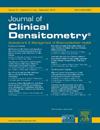The Relationship Between Antihypertensive Drugs and Osteoporosis in Postmenopausal Women: The ADiOS Study
IF 1.6
4区 医学
Q4 ENDOCRINOLOGY & METABOLISM
引用次数: 0
Abstract
Introduction: Hypertension (HT) and osteoporosis (OP) are common chronic diseases that often coexist in postmenopausal women. This study aimed to investigate the association between the use of antihypertensive medications and the presence of OP.
Methods: We retrospectively analyzed the medical records of 4166 postmenopausal women. Demographic data, age, weight, height, comorbidities, medications and bone mineral density values were collected for all patients screened/followed for OP between 2023 and 2024.
Results: Out of 4166 postmenopausal women, 1659 (39.8 %) were diagnosed with OP. After adjusting for potential confounders using binary logistic regression, diabetes mellitus [OR=0.785 (95 % CI=0.667-0.925) p = 0.004] and hyperlipidemia [OR=0.826 (95 % CI=0.698-0.978) p = 0.026] were negatively associated with OP. Among the antihypertensive medications (N = 2144); furosemide use [OR=1.918 (95 % CI=1.157-3.182) p = 0.012] was positively associated with OP, while thiazide use showed a negative association [OR=0.769 (95 % CI=0.619-0.954) p = 0.017].
Conclusions: Thiazide use was associated with a lower likelihood of OP, while furosemide use was linked to increased odds (about 1.9 times). Further research with larger samples and stratified analyses of antihypertensive classes is warranted to better understand these associations.
绝经后妇女降压药与骨质疏松的关系:ADiOS研究
高血压(HT)和骨质疏松症(OP)是绝经后妇女常见的慢性疾病。本研究旨在探讨降压药的使用与op的关系。方法:回顾性分析4166例绝经后妇女的医疗记录。收集2023年至2024年间所有OP筛查/随访患者的人口统计学数据、年龄、体重、身高、合并症、药物和骨密度值。结果:在4166名绝经后妇女中,1659名(39.8%)被诊断为op。使用二元logistic回归校正潜在混杂因素后,糖尿病[OR=0.785 (95% CI=0.667-0.925) p = 0.004]和高脂血症[OR=0.826 (95% CI=0.698-0.978) p = 0.026]与op呈负相关。降压药物(N = 2144);速尿使用与OP呈正相关[OR=1.918 (95% CI=1.157 ~ 3.182) p = 0.012],噻嗪类药物使用与OP呈负相关[OR=0.769 (95% CI=0.619 ~ 0.954) p = 0.017]。结论:噻嗪类药物的使用与OP的可能性降低有关,而速尿的使用与OP的可能性增加有关(约1.9倍)。为了更好地了解这些关联,有必要进一步研究更大的样本和降压药类别的分层分析。
本文章由计算机程序翻译,如有差异,请以英文原文为准。
求助全文
约1分钟内获得全文
求助全文
来源期刊

Journal of Clinical Densitometry
医学-内分泌学与代谢
CiteScore
4.90
自引率
8.00%
发文量
92
审稿时长
90 days
期刊介绍:
The Journal is committed to serving ISCD''s mission - the education of heterogenous physician specialties and technologists who are involved in the clinical assessment of skeletal health. The focus of JCD is bone mass measurement, including epidemiology of bone mass, how drugs and diseases alter bone mass, new techniques and quality assurance in bone mass imaging technologies, and bone mass health/economics.
Combining high quality research and review articles with sound, practice-oriented advice, JCD meets the diverse diagnostic and management needs of radiologists, endocrinologists, nephrologists, rheumatologists, gynecologists, family physicians, internists, and technologists whose patients require diagnostic clinical densitometry for therapeutic management.
 求助内容:
求助内容: 应助结果提醒方式:
应助结果提醒方式:


